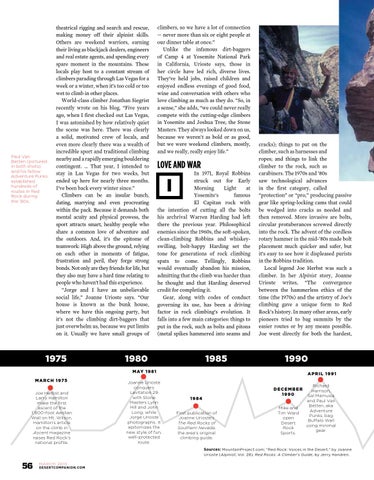Paul Van Betten (pictured in both shots) and his fellow Adventure Punks established hundreds of routes in Red Rock during the ‘80s.
theatrical rigging and search and rescue, making money off their alpinist skills. Others are weekend warriors, earning their living as blackjack dealers, engineers and real estate agents, and spending every spare moment in the mountains. These locals play host to a constant stream of climbers parading through Las Vegas for a week or a winter, when it’s too cold or too wet to climb in other places. World-class climber Jonathan Siegrist recently wrote on his blog, “Five years ago, when I first checked out Las Vegas, I was astonished by how relatively quiet the scene was here. There was clearly a solid, motivated crew of locals, and even more clearly there was a wealth of incredible sport and traditional climbing nearby and a rapidly emerging bouldering contingent. … That year, I intended to stay in Las Vegas for two weeks, but ended up here for nearly three months. I’ve been back every winter since.” Climbers can be an insular bunch, dating, marrying and even procreating within the pack. Because it demands both mental acuity and physical prowess, the sport attracts smart, healthy people who share a common love of adventure and the outdoors. And, it’s the epitome of teamwork: High above the ground, relying on each other in moments of fatigue, frustration and peril, they forge strong bonds. Not only are they friends for life, but they also may have a hard time relating to people who haven’t had this experience. “Jorge and I have an unbelievable social life,” Joanne Urioste says. “Our house is known as the bunk house, where we have this ongoing party, but it’s not the climbing dirt-baggers that just overwhelm us, because we put limits on it. Usually we have small groups of
1975
climbers, so we have a lot of connection — never more than six or eight people at our dinner table at once.” Unlike the infamous dirt-baggers of Camp 4 at Yosemite National Park in California, Urioste says, those in her circle have led rich, diverse lives. They’ve held jobs, raised children and enjoyed endless evenings of good food, wine and conversation with others who love climbing as much as they do. “So, in a sense,” she adds, “we could never really compete with the cutting-edge climbers in Yosemite and Joshua Tree, the Stone Masters. They always looked down on us, because we weren’t as bold or as good, but we were weekend climbers, mostly, and we really, really enjoy life.”
Love and war In 1971, Royal Robbins struck out for Early Morning Light at Yosemite's famous El Capitan rock with the intention of cutting all the bolts his archrival Warren Harding had left there the previous year. Philosophical enemies since the 1960s, the soft-spoken, clean-climbing Robbins and whiskeyswilling, bolt-happy Harding set the tone for generations of rock climbing spats to come. Tellingly, Robbins would eventually abandon his mission, admitting that the climb was harder than he thought and that Harding deserved credit for completing it. Gear, along with codes of conduct governing its use, has been a driving factor in rock climbing’s evolution. It falls into a few main categories: things to put in the rock, such as bolts and pitons (metal spikes hammered into seams and
I
1980
1985
cracks); things to put on the climber, such as harnesses and ropes; and things to link the climber to the rock, such as carabiners. The 1970s and ’80s saw technological advances in the first category, called “protection” or “pro,” producing passive gear like spring-locking cams that could be wedged into cracks as needed and then removed. More invasive are bolts, circular protuberances screwed directly into the rock. The advent of the cordless rotary hammer in the mid-’80s made bolt placement much quicker and safer, but it’s easy to see how it displeased purists in the Robbins tradition. Local legend Joe Herbst was such a climber. In her Alpinist story, Joanne Urioste writes, “The convergence between the hammerless ethics of the time (the 1970s) and the artistry of Joe’s climbing gave a unique form to Red Rock’s history. In many other areas, early pioneers tried to bag summits by the easier routes or by any means possible. Joe went directly for both the hardest,
1990
May 1 9 8 1 Ma r c h 1 975 Joe Herbst and Larry Hamilton make the first ascent of the 1,800-foot Aeolian Wall on Mt. Wilson. Hamilton’s article on the climb in Ascent magazine raises Red Rock’s national profile.
Joanne Urioste conquers Levitation 29 with Stone Masters Lynn Hill and John Long, while Jorge Urioste photographs. It epitomizes the new style of fun, well-protected route.
April 1991 December 1990
1984 First publication of Joanne Urioste’s The Red Rocks of Southern Nevada, the area’s original climbing guide.
Mike and Tim Ward open Desert Rock Sports.
Richard Harrison, Sal Mamusia and Paul Van Betten, aka Adventure Punks, bag Buffalo Wall using minimal gear.
Sources: MountainProject.com; “Red Rock: Voices in the Desert,” by Joanne Urioste (Alpinist, Vol. 28); Red Rocks: A Climber’s Guide, by Jerry Handren.
56
MARCH 2015
DesertCompanion.com
